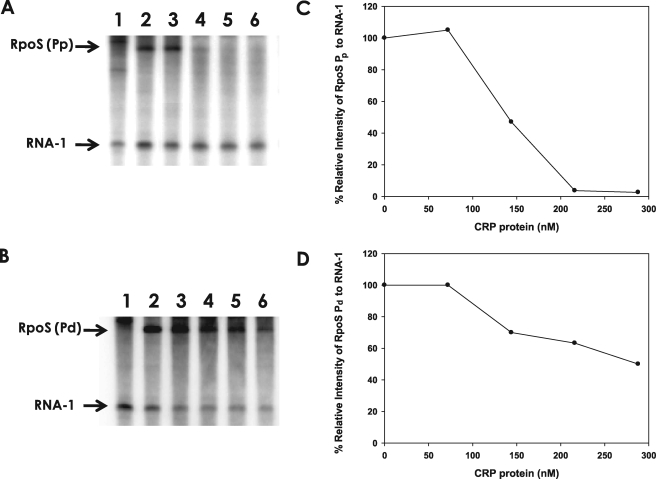FIGURE 5.
Repression of rpoS transcription by the cAMP-CRP complex. A, in vitro transcription at the rpoS promoter Pp in the presence of cAMP-CRP. The pRLG770 (24)-based plasmid carrying the rpoS Pp (prpoS-Pp) was used for a template for core RNAP, RpoD, and CRP derived from V. vulnificus (supplemental Fig. 1). Produced 32P-labeled transcripts were separated on 6.5% polyacrylamide/bisacrylamide (19:1), 7 m urea denaturing gel showing two RNA bands (the control RNA of 108-nucleotide-long RNA-1 and the 210-nucleotide-long rpoS RNA) on each lane. Lane 1, pRLG770 (no rpoS promoter); lanes 2–6, prpoS-Pp incubated with 0, 72, 144, 216, or 288 nm of CRP. B, in vitro transcription at the rpoS promoter Pd in the presence of cAMP-CRP. The pRLG770 (24)-based plasmid carrying the rpoS Pd (prpoS-Pd) was used for an assay, which resulted in production of RNA-1 and 188-nucleotide-long rpoS RNA. Lane 1, pRLG770; lanes 2–6, prpoS-Pd incubated with 0, 72, 144, 216, or 288 nm of CRP. C and D, plots illustrating the relative intensity of rpoS transcript. The intensities of two RNA bands on each lane, the 108-base RNA-1 transcript, and the longer transcript starting from one of the rpoS promoters were estimated by densitometric reading (the plot C is from A, and the plot D is from the B), and then each rpoS transcript was normalized to RNA-1 on the same lane. Relative intensity of the normalized rpoS transcript was indicated as the percentage of that in the absence of CRP.

